Markus Duhme, a seventh-grader from Vancouver, British Columbia recently worked on a science research project about Snowy Owls for his school’s Wonder Expo. We are happy to see this young researcher used data on Columbia, a female Snowy Owl who was tagged and released at Goose Pond Sanctuary on January 28, 2020 (read our first feature about her here). As of early April 2023, she is in southwest Manitoba.
Markus Duhme presents his research at his schools’s Wonder Expo in Vancouver, British Columbia (photo courtesy of the Duhmes).
Wonderfully, he was able to do so because Project SNOWstorm endeavors to make as much information available to the public as possible (for the space and safety of the owls, all tracking data from currently tagged owls is released after a 24 hour delay). Read a little more on the Project SNOWstorm blog by Scott Weidensaul here.
We recently reached out to Markus to learn more about his project. He describes the purpose for his research: “I chose my Wonder Expo topic because of my love for birds. When I was reading A World on the Wing by Scott Weidensaul, I saw a line referring to Project SNOWstorm, an organization that he had created, which focused on researching snowy owls. Instantly I knew what I wanted to do for my Wonder Expo. . . . I have not only learned a lot about snowy owls, I have also become even more fascinated with all birds in general.“
Columbia the Snowy Owl (photo by Monica Hall).
His hypothesis was, “If we compare when and how far snowy owls travel in relation to the different months of the year, then we will find that they will be active (meaning how far they travel) earlier in the summer and later in the winter. We will also find that they will travel greater distances during the months of June and December while barely traveling during July. This is because snowy owls are thought to be diurnal and most active at dawn and dusk. This means that when the days lengthen they should be active earlier in the morning and later in the evenings. When the days shorten they will be active later in the morning and earlier in the evenings. Because snowy owls migrate from the high arctic down to southern Canada during the months of June and back up to the arctic in December, we will see a spike during these months. Snowy owls breed during July meaning that they should stay in the same spot for most of the month (more so in females as they have to guard their eggs). This should translate into a decrease in the amount they travel.“
“To find my answer, I used coordinates obtained through GPS satellite tagging, collected by Project SNOWstorm and calculated the distance between them,” said Markus. Through a detailed and well-defined procedure, he analyzed over over 2,500 data points for two owls—Columbia (female) and Otter (male).
Graph comparing how far Columbia and Otter travel during different months (by Markus Duhme).
According to his research, “There was a clear connection between when snowy owls traveled, and the different times in an owl's life (wintering, breeding, and migrating). My two study owls both appeared to migrate at night, which contradicts what some scientists believe about the snowy owls' behavior. When in their wintering grounds, they appeared to both be more active during the daytime, rather than at night. During the breeding season, they appeared to not follow any discernible pattern, as the data showed no distinct similarities. I also found that the snowy owls appeared to start migrating during the month of April, stopped in July, and started up again during September.”
We are grateful to Markus for sharing his time and research about Columbia with us. To read Markus’s full report, click here (PDF).
Written by Markus Duhme with Susan Foote-Martin and Mark Martin, Goose Pond Sanctuary resident managers
Cover image by Arlene Koziol. A Snowy Owl takes flight over water.








